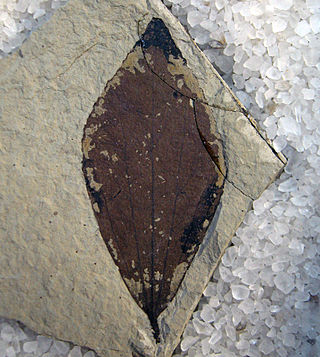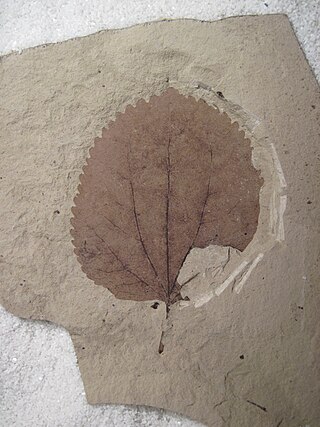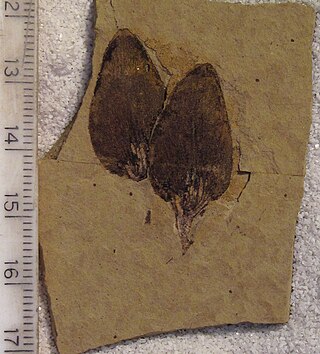
Trochodendron is a genus of flowering plants with one living species, Trochodendron aralioides, and six extinct species known from the fossil record. It was often considered the sole genus in the family Trochodendraceae, though botanists now also include the distinct genus Tetracentron in the family.

Tetracentron is a genus of flowering plant with a sole living species being Tetracentron sinense and several extinct species. It was formerly considered the sole genus in the family Tetracentraceae, though it is now included in the family Trochodendraceae together with the genus Trochodendron.

Trochodendraceae is the only family of flowering plants in the order Trochodendrales. It comprises two extant genera, each with a single species along with up to five additional extinct genera and a number of extinct species. The living species are native to south east Asia. The two living species both have secondary xylem without vessel elements, which is quite rare in angiosperms. As the vessel-free wood suggests primitiveness, these two species have attracted much taxonomic attention.

Florissantia is an extinct genus of flowering plants in the Malvaceae subfamily Sterculioideae known from western North America and far eastern Asia. Flower, fruit, and pollen compression fossils have been found in formations ranging between the Early Eocene through to the Early Oligocene periods. The type species is Florissantia speirii and three additional species are known, Florissantia ashwillii, Florissantia quilchenensis, and Florissantia sikhote-alinensis.

Trochodendron nastae is an extinct species of flowering plant in the family Trochodendraceae known from fossil leaves found in the early Eocene Ypresian stage Klondike Mountain Formation deposits of northern Washington state. T. nastae is one of the oldest members of the genus Trochodendron, which includes the living species T. aralioides, native to Japan, southern Korea and Taiwan and the coeval extinct species T. drachukii from the McAbee Fossil Beds near Cache Creek, British Columbia.

Dillhoffia is an extinct monotypic genus of flowering plant with a single species, Dillhoffia cachensis known from Ypresian age Eocene fossils found in British Columbia, Canada, and Washington, USA. The genus and species were described from fifteen specimens found in an unnamed formation belonging to the Kamloops group shales; and two specimens from the Klondike Mountain Formation. The unnamed formation outcrops at the McAbee Fossil Beds near Cache Creek, BC, which is designated the type locality while the two U.S. specimens were recovered from the Tom Thumb Tuff member of the Klondike Mountain Formation in Republic, Washington. It is of interest to note that of the Okanagan highlands fossil sites Dillhoffia is only known from two locations, and is absent or has not been identified from the others.
Trochodendron drachukii is an extinct species of flowering plants in the family Trochodendraceae known from a fossil fruiting structure found in the early Ypresian age Eocene fossils found in British Columbia, Canada. T. drachukii is one of the oldest members of the genus Trochodendron, which includes the living species T. aralioides, native to Japan, southern Korea and Taiwan and the coeval extinct species T. nastae from Washington state, United States.

Ginkgo dissecta is an extinct ginkgo species in the family Ginkgoaceae described from a series of isolated fossil leaves. The species is known from Early Eocene sediments exposed in the province of British Columbia, Canada, and Washington, US. It is one of two Ginkgo species found at the Washington and British Columbia sites.
Neoephemera antiqua is an extinct species of square-gill mayfly in the family Neoephemeridae that is known from early Eocene, Ypresian stage, lake deposits near the small community of Republic in Ferry County, Washington, USA.
Acer toradense is an extinct maple species in the family Sapindaceae described from two fossil samaras. The species is solely known from the Early Eocene sediments exposed in northeast Washington state, United States, and the adjacent area of south central British Columbia, Canada. It is one of three species belonging to the extinct section Torada.
Acer republicense is an extinct maple species in the family Sapindaceae described from a single fossil samara. The species is solely known from the Early Eocene sediments exposed in northeast Washington state, United States. It is the only species belonging to the extinct section Republica.

Rhus garwellii is an extinct species of flowering plant in the sumac family Anacardiaceae. The species is known from fossil leaves found in the early Eocene deposits of northern Washington State, United States. The species was first described from fossil leaves found in the Klondike Mountain Formation. R. garwellii likely hybridized with the other Klondike Mountain formation sumac species R. boothillensis, R. malloryi, and R. republicensis.
Rhus republicensis is an extinct species of flowering plant in the sumac family, Anacardiaceae. The species is known from fossil leaves found in the early Eocene deposits of northern Washington state in the United States. The species was first described from fossil leaves found in the Klondike Mountain Formation. R. republicensis likely hybridized with the other Klondike Mountain formation sumac species Rhus boothillensis, Rhus garwellii, and Rhus malloryi.
Concavistylon is an extinct genus of flowering plant in the family Trochodendraceae comprising a single species Concavistylon kvacekii. The genus is known from fossils found in Middle Miocene deposits of central Oregon. A second species "Concavistylon" wehrii was originally placed in Concavistylon, but subsequently moved to a new genus Paraconcavistylon in 2020.

Tetracentron hopkinsii is an extinct species of flowering plant in the family Trochodendraceae. The species is known from fossil leaves found in the early Eocene deposits of northern Washington state, United States and south Central British Columbia. The species was first described from fossil leaves found in the Allenby Formation. T. hopkinsii are possibly the leaves belonging to the extinct trochodendraceous fruits Pentacentron sternhartae.
Trochodendron postnastae is an extinct species of flowering plant in the family Trochodendraceae. The species is known from fossils found in Middle Miocene deposits of central Oregon. T. postnastae are possibly the leaves belonging to the extinct trochodendraceous fruits Trochodendron rosayi.
Trochodendron rosayi is an extinct species of flowering plant in the family Trochodendraceae. The species is known from fossils found in Middle Miocene deposits of central Oregon. T. rosayi are possibly the fruits belonging to the extinct trochodendraceous leaf species Trochodendron postnastae.
Paraconcavistylon is an extinct genus of flowering plant in the family Trochodendraceae comprises a single species, Paraconcavistylon wehrii. The genus is known from fossil fruits and leaves found in the early Eocene deposits of northern Washington state, United States, and southern British Columbia, Canada. The species was initially described as a member of the related extinct genus Concavistylon as "Concavistylon" wehrii, but subsequently moved to the new genus Paraconcavistylon in 2020 after additional study.

Pseudolarix wehrii is an extinct species of golden larch in the pine family (Pinaceae). The species is known from early Eocene fossils of northern Washington state, United States, and southern British Columbia, Canada, along with late Eocene mummified fossils found in the Qikiqtaaluk Region, Nunavut, Canada.
The Paleobiota of the Klondike Mountain Formation comprises a diverse suite of Early Eocene plants and animals recovered from North Central Washington State. The formation outcrops in locations across the north western area of Ferry County, with major sites in Republic, north west of Curlew Lake, and on the Toroda Creek area. The formation is the southern most of the Eocene Okanagan Highlands, sharing much of the paleoflora and paleofauna with site across Central and southern British Columbia.









